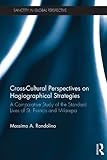Cross-Cultural Perspectives on Hagiographical Strategies A Comparative Study of the Standard Lives of St. Francis and Milarepa
Language: English Publication details: Oxford Routledge 20170112Edition: 1Description: 242 pISBN:- 9781317156949
This book examines the potential of conducting studies in comparative hagiology, through parallel literary and historical analyses of spiritual life writings pertaining to distinct religious contexts. In particular, it focuses on a comparative analysis of the early sources on the medieval Christian Saint Francis of Assisi (1182-1226) and the Tibetan Buddhist Milarepa (c. 1052-1135), up to and including the so-called ‘standard versions’ of their life stories written by Bonaventure of Bagnoregio (1221-1274) and Tsangnyön Heruka (1452-1507) respectively. The book thus demonstrates how in the social and religious contexts of both 1200s Italy and 1400s Tibet, narratives of the lives, deeds and teachings of two individuals recognized as spiritual champions were seen as the most effective means to promote spiritual, doctrinal and political agendas. Therefore, as well being highly relevant to those studying hagiographical sources, this book will be of interest to scholars working across the fields of religion and the comparative study of religious phenomena, as well as history and literature in the pre-modern period.
There are no comments on this title.
